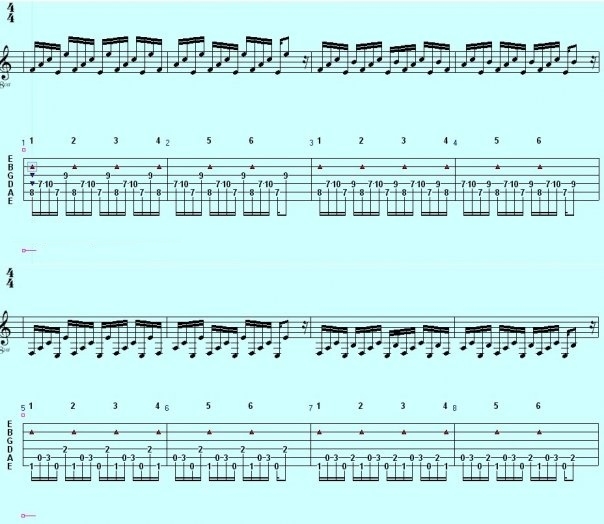In today's riff we are going to use only 5 notes, but as you will see, these recurring notes can have a spectacular effect.
The first 3 notes are F – A – C (which is an F major triad), and the last 2 notes are E and its octave.
If you play these 5-note-sequence continuously in sixteenth, the starting points of the recurring sequence and the four beats of the 4-4 measure will not coincide.
Let's see this process in the first 2 measures! At the beginning of the first measure, the starting point of our sequence falls on the first beat. A 4-4 measure consists of 16 sixteenths, grouped in four sixteenths. So the second beat comes at the 5. sixteenth of the measure, which is in this case the last note of the sequence (F – A – C – E – E ).
As a consequence, the second starting point (i.e. the moment as you start playing these 5 notes for the second time) falls on an upbeat. This point is marked with a '2' on the tablature, between the TAB and the standard notation.
As you finish the sequence for the second time, you will now have a "bonus" of 2 sixteenth notes, because you have played 10 notes so far, being 2 notes ahead the conventional spacing of groups of four. After the third time you will be 3 notes ahead the beat, after the fourth time 4 notes ahead, and so on.
When you sum it up, the 5-note sequence can be played six times in the first 2 measures. This gives 30 notes, so we have only 2 notes left till the end of the second measure (2 measures in 4-4 consist of 32 sixteenth). In this example we utilize this 2 more remaining notes by extending the last E note by an additional sixteenth, as well as by putting a final sixteenth rest at the very end.
(Note that if we had a more conventional theme consisting of 4 notes, we could have played it 8 times!)
So using this method of repeating odd numbers of notes as a theme, we can easily lend color to our riffs, because of the constant 'whirling' of beats and theme starting points. You will no doubt hear this effect when you listen to the sample. Having five simple notes (a major triad and an octave interval), you would be normally no Grammy-candidate, but you will surely have some chances if you mix the beats up according to the above cheap rhythm trick!
In the following 2 measures I have repeated the entire process, but this time I used the note B instead of E as the last note of the 5-note-theme (F – A – C – E – B ). And in bars 5-8, the whirling and tilting occurs an octave lower, so we have put together a whole section of a song, which is 8 measures long, and the listener can at no point foresee, what happens next.
Question #1: out of your own riffs, what is the riff, you're most proud of, in terms of creativity?
Question #2: what is your favorite creative riff, from one of your fave artists/bands?

You are at GuitarMasterClass.net
Don't miss today's
free lick. Plus all our lessons are packed with
free content!